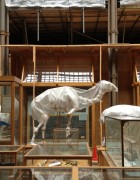At the Royal Institution last week for an event sponsored by the CX program I ran another iteration of the social network modelling project. The main difference this time was that 28 participants contributed to a group model rather than creating individual versions as we had done in Elephant and Castle. There were a number of key observable differences between the two approaches.
An early participant labelled her presence in the network by writing her Twitter handle next to her individual pin. She did this quite unprompted by the researchers with the effect that many others did the same and the whole model became a mechanism for connecting and sharing on Twitter. This unconscious action was thus seen to have a cascading effect on how participants self-described and how the physical model embodied a digital network.
Most people have a mental model of their social network, with friends, family, colleagues etc identified and the web of connections between them held in consciousness in some way. Doing the task required this mental model to be externalised in physical form and made visible to others. A few conference attendees did know each other already and some of them created a network together. Others placed themselves at some distance as an indication of their relative isolation in the conference setting. Most people did the task alone -placing a pin for themselves – and connecting to one other person.
Making individual social network models did not result in much alteration of the physical layout once the task had started when we did the project in Elephant. People externalised their network according to an inner structure. This could be for a number of reasons; the stability of the substrate and materials, the coherent and individualised nature of the task and time limitations. At the Royal Institution, the group representation elicited more changes in the form of corrections, replacements, and revisions. This could partly be because the surface was less stable but also because it covered a larger area allowing for greater discovery and surprise.
As the representation grew in extent with each response, so it gained granularity and resolution. With more contiguous different participant pins, there was an increased chance for people to recognise others and demonstrate that they knew them. Since each connection was labelled by name and Twitter handle, participants experienced a level of surprise, serendipitous discovery, and delight that was missing from the experience of doing the task alone, albeit co-present with others. Creating group representations can provide different forms of experience than individual representations and allow for more profound reflection beyond self recognition.
Constructionism as a psychological theory of knowledge is normally concerned with learning processes and education and how people construct knowledge in social settings. Theories of constructionism emphasise language as the key mechanism by which externalisation is achieved – by telling something it comes into being. Social constructionism takes the knowledge building out of education and applies it more generally to situations where people construct meaning together through coordinated action. The role of artefacts in knowledge construction has been extensively explored by anthropologists, psychologists and others. In HCI, computer artefacts, including software environments, have also long been a subject of research. By providing an opportunity for group interaction focused on the construction of a map of social network connections I hope to engage participants in a process of reflective narrative construction about digital networks, social media, and the intangible distribution of social information.


